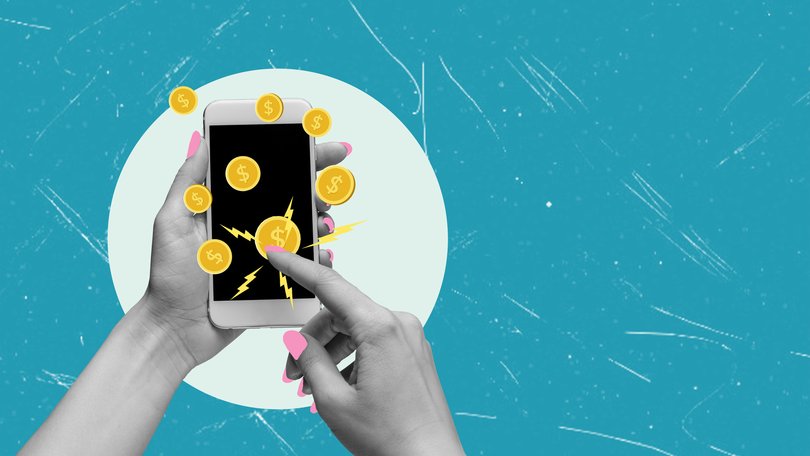RACHEL JIMENEZ: How I built an Etsy side hustle bringing in $10k a month in passive income

Four years ago, I was struggling and wanted to make a change in my life.
I was dealing with postpartum depression after the birth of my second child and felt unfulfilled by my 9-to-5, a higher education administration job. I was also going to school part-time to earn my master’s degree in Positive Organizational Psychology.
I decided to start an Etsy store, selling digital products like business templates and party games. It was not an overnight success, and it’s true that being a parent meant that I had additional demands on my time and schedule — especially with two kids under the age of four.
Sign up to The Nightly's newsletters.
Get the first look at the digital newspaper, curated daily stories and breaking headlines delivered to your inbox.
By continuing you agree to our Terms and Privacy Policy.Today, at 36, I have a thriving living room side hustle that regularly brings in $10,000 a month or more in passive income. Here is how I built it:
1. I focused on achieving more by doing less
About a year into trying to get the business aloft, I was exhausted and frustrated.
I was making the products I wanted to make, but I wasn’t getting very far creating in a vacuum. I spent months posting to social media, writing blog posts, jumping from product to product, brainstorming course ideas — everything was falling short.
When I dug into my customer stats, I was surprised to find that while the revenue was small, a series of budgeting templates I created sold consistently.
In a moment of clarity, I remembered that Peter Drucker, the management expert, once said, “Efficiency is doing things right. Effectiveness is doing the right thing.” With my limited time, I knew I couldn’t afford to spend time on actions that wouldn’t get results.
So I decided to stop everything that wasn’t generating revenue (like trying and failing to go viral on Instagram) and focused solely on doing what I empirically knew would make the Etsy store better.

2. I got better at using data to help inform my decisions
When I started selling digital products on Etsy, I made budget planners because I was passionate about budgeting, and they were easy to create.
However, I realized that they didn’t sell that well, because there was a lot of competition and not much demand. Over time, I learned the importance of following trends and finding product ideas with low competition and high demand.
I learned the importance of following trends and finding product ideas with low competition and high demand.
Today, I’m a big fan of using tools like Pinterest trends, Google trends and eRank. I’ve found the some of the best low-competition, high-demand products are niche products related to specific interests or professions.
For example, digital planners get a lot of search but have a lot of competition, whereas ADHD planners get a good amount of search volume with much less competition. Once I understood this, my results and revenue began to steadily improve.
3. I took consistent action every day
I took a course about selling digital products on Etsy back in 2019 that jump-started everything.
Thanks to the class, and studying people who were running successful stores, I realized the importance of market research and testing — before putting all my money and time into something that wasn’t going to resonate.
Another big lesson I learned was the importance of beautiful listing images. When I first started I would put a lot of energy in my product and then I would be exhausted, so I would rush the listing images. The product is important, yes, but how you sell it matters. The listing images and the first impression buyers matter more than you may realize.
Most importantly, as I implemented these changes, I monitored my progress and took consistent action every day.
I would try to work six to eight hours a day developing and listing products. I would eliminate distractions and get into the zone — but I would stay flexible depending on the needs of the day. If I was holding my daughter, I would focus on learning by watching videos. When she slept and my hands were free, I focused on creating.
If you’re feeling overwhelmed by your responsibilities and unsure if you can pull off a side hustle, remember this: small, consistent actions lead to big results.
4. I realized I couldn’t do it alone
In order to make the business happen, I quickly realized that I had to get comfortable asking for, and even paying for, help.
We were able to hire a housekeeper, and my husband took care of chores like cooking meals, so all my focus could be on building the business.
If you’re feeling overwhelmed by your responsibilities and unsure if you can pull off a side hustle, remember this: small, consistent actions lead to big results.
After my digital product class ended, I stayed active in our Facebook group. I posted almost every day and remained engaged in the community online.
I stopped worrying about being annoying or asking too many questions. I just leveraged the resources I had available to me, to the best of my ability.
5. I made short-term sacrifices for long-term benefits
My daughter was born in May of 2020. Looking back, launching the business during my maternity leave, during the height of the pandemic, was a way to feel like myself during an uncertain time.
During my leave, I spent any free moment that I wasn’t feeding her or taking care of my family, I focused on building my business. When I went back to work, nights and weekends belonged to my side hustle.
I know that if I had to do it all again the same way, I would. Those few months of sacrifice have continued to pay dividends, and now, I’m able to spend as much time with my children as I want.
There’s a model in positive psychology called the PERMA model for well-being. You need all five components — positive emotion, engagement, relationships, meaning and accomplishment — to flourish.
Working on my side hustle helped me feel engaged, build new relationships, have meaning, and feel accomplished. The positive emotion comes from seeing my labor pay off.
Reflecting now on how I built my business, I realize it wasn’t about being superhuman or having endless energy — it was about being strategic, focusing on what really mattered and not being afraid to ask for help. Now I have the freedom and flexibility I once dreamed of, all while doing something I love.
Originally published on CNBC
